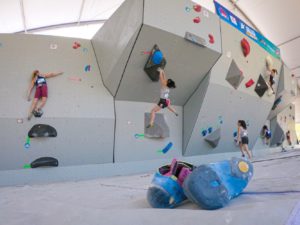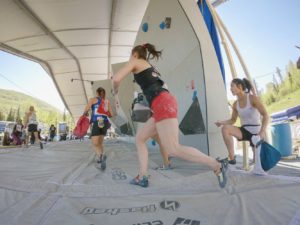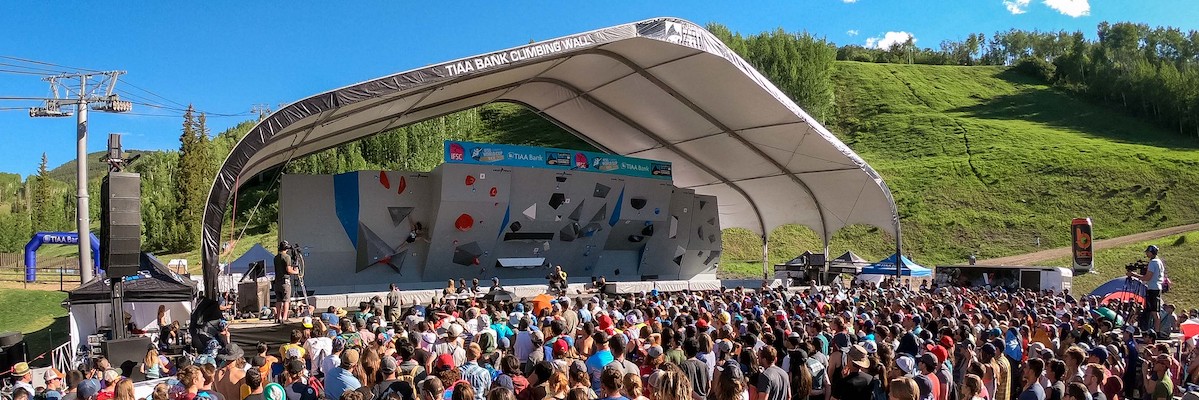Posted by: Katie Coakley
A walk-through of rules and terms for the first-time spectator
By Shauna Farnell
The suspense is palpable watching the world’s best climbers scale artificial walls that look utterly insurmountable for any bipedal species. The action is nonstop during the 2019 IFSC Climbing World Cup’s one and only stop in North America but, because it is the tour’s only stop in a place where one’s senses are flooded with the action of dozens of other outdoor sports, a few elements might need clarification for the uninitiated spectator.
The disciplines

There are three disciplines in World Cup climbing: speed, lead and bouldering. Bouldering is on display in Vail in which the objective is for athletes to climb five different walls – called boulders or problems – featuring unique features (holds).
“Speed, that’s simple. It’s time measurement: How fast was it? Lead is scored on height: how high up the wall you can get. Here, there are five boulders. How many can you get to the top of?” says IFSC World Cup Jury President Tim Hatch. “It’s simpler than one would think.”
Top athletes from nearly two dozen nations compete; each athlete gets five minutes to attempt to climb each problem.
“You have five minutes both to climb it and figure out how to climb it,” Hatch says. “The absolute best is to do them each in one go.”
When a climber gets to the top of a problem on the first try, it’s called a “flash.” For climbers who don’t flash, weariness sets in as the five minutes slip by, especially at 8,150 feet.
“If you start to be bad on one boulder, you are going to make a lot of attempts and get tired and have less chance and less energy for the rest of the circuit,” points out IFSC Technical Delegate Christophe Billon.
“If they think they can do the boulder, they’ll take as many attempts as they think they need to get it,” Hatch says. “You’ll see other climbers who’ll decide they can’t do it. They’ll stop after two or three attempts because they do the mental arithmetic and decide it’s better to get five, six minutes of good rest, then start the next boulder.”
The holds
The holds vary from small round nubs to upside-down triangles.
“The most difficult holds are not always the ones you think,” Billon says. “When it’s an overhang, it looks impressive, but sometimes the method is easy to find.”
Each wall contains a “zone hold,” which, if used, adds to the athlete’s score. On a score, you’ll see “Ts,” which signify tops and “Zs,” which signify zone holds.
“In an ideal competition, you’d have one climber with five tops, then another with four tops, another with three, another with two. There are climbers in the field who won’t be able to get to the top, so we need a way to split them,” Hatch says.
 Climbers must wait behind the wall until it’s their turn on each problem.
Climbers must wait behind the wall until it’s their turn on each problem.
“They’re meant to do the boulders without any knowledge of them at all,” Hatch says. “It’s a little difficult here, because of the venue. Ideally, when they come out from behind that wall, it’ll be the first time they see the boulder and the real problem.”
The moves
Climbers make a variety of moves to reach holds: dynamic moves (dynos) and coordinated moves.
“Dynamic moves are jumps; they can be vertical or sideways,” Hatch says. “You have coordination movements, where the only way to describe it is to swim your way across the boulder and you’re never stationary at any point in time.”
Only 20 of the top men and women make it from qualifiers to semi-finals – only six make it to finals.
Cheer ’em on
“Climbers really like to be supported,” Billon says. “You scream and it helps them. Sometimes you see athletes ask for support from the audience. They really do their best when the audience pushes them.”
The IFSC World Cup qualifiers are Friday. Semifinals are at 9:30 a.m. Saturday; female finals kick off at 3 p.m. and male finals at 4:45 p.m. Saturday at the TIAA Bank Climbing Wall in Vail’s Mountain Plaza.
Next year, in 2020, Climbing makes its Olympic debut in Tokyo with a combined format of all three disciplines – bouldering, speed and lead.
Glossary of Terms:
Boulder or problem (n) – the wall and its set of holds
Holds (n) – features on the wall
Top (v,n) – Reaching the top of the wall
Zone hold (n) – A hold designated for scoring in addition to tops
Flash (v,n) – Reaching the top of the wall on the first try
Dyno (n) – A vertical or sideways jump move
Share this Story:






















